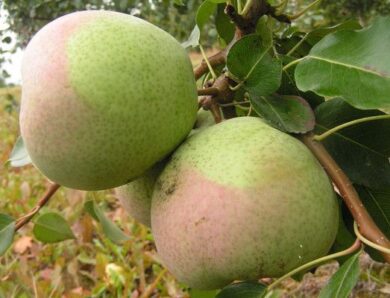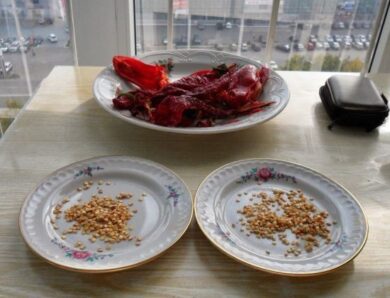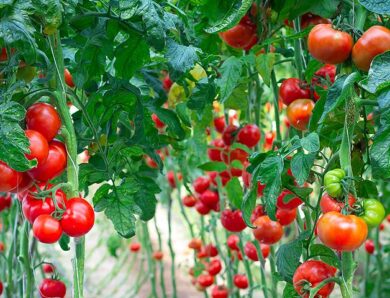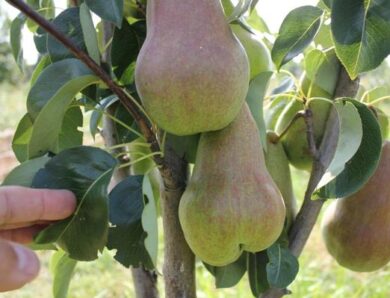How to increase the yield of cucumbers in the greenhouse at any time of year
In modern greenhouses cucumbers are grown all year round, therefore, for gardeners and farmers, the issue of increasing vegetable yields is always at the forefront. Everyone knows, that for good fruiting culture it is necessary to provide the most favorable conditions: lighting, water, top dressing, temperature regime. But unfortunately, even if all the rules of agricultural technology are followed, the yield of cucumbers in the greenhouse often remains low. What moments were missed and what to do with low yields? You will learn about this from our article.
The best varieties
The yield of cucumbers is influenced by many factors, and not the last place in this list is given to the choice of variety. Of course, can be argued, that with good care any cucumbers will yield, but that fact should not be ruled out, that some plants in the greenhouse do not yield at all or simply die from heat and humidity. And the reason for this phenomenon is, that the variety is not intended for greenhouses, and for open ground.
For planting in a greenhouse you need to choose hybrid varieties with the designation "F1". The number "1" means, that it is a hybrid of the first generation, that is, it was obtained by crossing two pure varieties. Such cucumbers have higher characteristics:
- normally tolerate temperature changes, increase humidity, cold or heat;
- capable of self-pollination;
- have a short growing season (mature earlier);
- characterized by abundant fruiting;
- resistant to disease;
- the taste has no characteristic bitterness.
Ideally, if all these indicators are combined in one hybrid, then the yield of cucumbers will be high. But also not bad, if the variety is undemanding to growing conditions, as even in the most modern and equipped greenhouses force majeure situations can occur. What a nuisance, if, due to a slight decrease in temperature, the plants stop tying the fruit or worse, will die from it, that the greenhouse is not ventilated and it is too hot. That this did not happen, you should choose hybrids, able to withstand as heat, and cold.
White night F1
A hybrid of the early (40-44 of the day) maturity with abundant mass fruiting and high yields (to 12 kg with 1 m? Squares). The fruits are small (8-9 cm), cylindrical, average weight 90-120 G.
Pinocchio F1
Early-maturing hybrid (42-46 days), possessing high immunity to cold. Can be grown in open ground. The fruits are medium (8-9 cm and weigh about 100 G), wide, hilly along its entire length, ripen en masse, well transported. Yield - 11-13 kg / 1 m? landing.
Emel F1
Early (40-42 of the day) hybrid for greenhouse cultivation. Shrubs are vigorous, form mainly female flowers, therefore the yield is high (to 16 kg / 1 m?). The variety is resistant to diseases, in particular fungal. The fruits are aligned, the surface is hilly, 13-15 cm long and weighing up to 150 G.
Beer F1
Universal early-maturing hybrid can be grown in soil under film and in greenhouses. The fruits are medium (to 11 cm and weigh about 100 G), very hilly. Yield - 10-11 kg. Insect pollination is required.
summer resident F1
Hybrid of early fruiting - 42-45 days. Gherkins of small weight (70-90 G), but due to the large number of ovaries, formed by female flowers, the yield is impressive - up to 18 kg / 1 m ?.
mascot F1
Medium-ripe hybrid (50-54 days) with impressive resistance to almost all diseases. The fruits are medium (to 12 cm), wide, very hilly, mass to 200 G. Yield - up to 14 kg.
Barcelona
Early (40-42 days) hybrid with medium disease resistance. The fruits are long (to 16 cm), aligned, medium hilly, mass about 140 G. The female type of flowering prevails. Yield - up to 13 kg.
To this list you can add cold-resistant varieties "Bobrik", "Matrix", "Emerald", early ripening: "Cuckoo", "Charge", "Courage", "May" and many others.
Video "Best varieties for greenhouses"
You will learn from the video, what varieties of cucumbers are suitable for growing in greenhouses.
seed preparation
Once the variety is selected, attention should be paid to seed preparation. Simply sowing in the ground and watering is not an option, since half of them may not germinate. Preliminary preparation of seeds will not take much time, but the rate of sprouting and seedling quality will increase markedly, which will generally lead to higher yields.
The preparatory process consists of the following stages:
- first, immerse the seeds in warm water for a few hours to soften the shell;
- then drain the water, and the seed is placed in saline (50 g of salt / 1 And water), then perform calibration - seeds, which surfaced, delete, as they are empty and unsuitable for sowing;
- full-fledged seeds, sank to the bottom, wrap in gauze and place in a thermos with water 45-50 ° C for a few more hours;
- the heated material is disinfected in a solution of manganese about 30 minutes, then rinse thoroughly under running water.
If desired, you can prepare a nutrient solution of ash (2 Art. Spoons / 1 And water) and immerse in it the prepared seeds on 1,5-2 years. This treatment promotes earlier germination and gives plants immunity to external negative factors.
cultivation technologies
Growing greenhouse cucumbers requires compliance with all agronomic rules and techniques - only in this case you can hope for a good and quality harvest. What cucumbers need for mass fruiting? Proper care and maintenance of the necessary conditions for growth:
- Moisture. Cucumbers love abundant watering, but water the plants only under the roots and in the evening. Irrigation in the greenhouse is not recommended, as the risk of fungal diseases increases.
- Growth stimulants. There are special drugs to accelerate plant development, but if you are a fan of all things natural, then right in the greenhouse you can put a container of water, in which to throw fresh nettles. In a few days, when the nutrient solution turns dark, the liquid can be used to water the bushes, and the remaining solution will evaporate and create a favorable microclimate for plants.
- Formation of bushes. Almost all greenhouse varieties are indeterminate. If their stems are not pinched, and do not remove extra stepsons, then the whips can grow indefinitely, creating impassable thickets to the detriment of the number of fruits.
- Tying to the support. In greenhouse conditions, tying the shoots is mandatory, otherwise they will unravel on the ground. Ordinary vertical wallpaper or netting is used to tie cucumbers. The classic wallpaper is a frame made of durable material with hooks and loops, to which metal rods fasten (wire). You can use a strong rope instead of wire. The wall-paper design is established vertically, this method significantly saves the area of the greenhouse, and allows you to direct the plants up.
As an option, for wandering vegetable crops you can use a special net, which by analogy with the wallpaper is stretched between the two support columns. It is also convenient to use two grids of a grid, which are attached to each other at an angle, forming something like a tent. Ripening fruits on such a structure hang down beautifully, which greatly facilitates their collection.
soil preparation
It is known, that in bad soil plants do not develop and therefore it is not necessary to count on high productivity. Before planting seeds or ready-made seedlings in the greenhouse, it is necessary to prepare and improve the soil. High-quality soil mixture for cucumbers should have the following characteristics:
- be porous, easy, well drained;
- have a neutral or slightly acidic reaction;
- the upper layer contains organic and balanced mineral composition.
To improve the quality characteristics, in particular fertility, humus is added to the sod soil, compost, or form a substrate of peat (50%), humus (30%) and meadow or sod land (20%). You can increase the drainage properties of the soil by making sawdust (preferably from coniferous trees), or coarse river sand.
Preparation of the soil for growing cucumbers should be carried out in advance. Preparatory work for spring planting is carried out in autumn, immediately after harvest. If cucumbers are grown in a greenhouse all year round, then prepare the bed at least a month before planting. It is important to understand, that the soil in the greenhouse should periodically "rest" - at least a month after fruiting.
As soon as the next harvest is over, the bed is cleaned of all plant debris, dug to a depth 25-30 cm, at the same time clearing the soil of other roots, and disinfect with a solution of copper sulfate (7%). If the site is depleted, we make organic (manure, compost). In this state, leave the bed until the next planting. Just before planting cucumbers, but not before, than a month later, mineral fertilizers are applied: superphosphate, potassium sulfate and ammonium nitrate.
planting seeds
The term of sowing seeds is determined by varietal characteristics. By this time, the soil and air should be warmed in the greenhouse. The period from the beginning of April to the first decade of May is considered optimal for planting. At year-round cultivation it is better to use ready seedling, as in the winter season the vegetative process is less active, and plants need special care.
If the seeds are sown directly in the greenhouse, then it is done in this order:
- the bed is leveled and well watered;
- deepenings are made in the moistened soil (rows or holes) depth of about 2 cm;
- in each hole or row at a distance 10-15 see we put on 3-4 seeds;
- then the seeds are covered with soil.
That moisture from soil did not evaporate, until the first sprouts, the bed is covered with a transparent film. Periodically, the shelter is removed for ventilation and watering - before the seedlings, the soil should be wet. This technology of sowing provides simultaneous germination of seedlings in the shortest possible time.
growing in winter
Modern stationary greenhouses allow you to grow cucumbers all year round, and with the right approach, the yield of the winter season may not be inferior to the traditional spring-summer. Year-round cultivation is more commonly practiced for commercial purposes, but there are many gardeners, who prefer to have their own on the table in winter, and not bought fresh cucumbers.
In winter, cucumbers in the greenhouse should be grown from seedlings, and varieties to choose only cold-resistant, which do not need pollinators and long daylight for fruiting. It is better to grow seedlings in disposable pots or cups on peat substrate - such a plant is easily removed from the planting container with a lump of earth, what is required by cucumber farming techniques.
In the greenhouse seedlings are planted at a distance 20-25 see and 70-90 see between the lines. This distance is determined ??team, that greenhouse hybrids are prone to intensive growth and branching. If they are planted more densely, beds will be excessively thickened and this will negatively affect yields.
In general, the process of growing winter cucumbers is no different from summer. The only difference, that in the spring the greenhouse can not be heated, and daylight is enough for normal vegetation. In winter, heating and additional lighting is a prerequisite for creating a favorable microclimate. It is desirable to use a stationary water system for heating, rather than portable heaters. Heaters dry the air very much, in addition, they must always be switched on to maintain the required temperature, and this is an additional cost.
As for lighting, even if you use shade-tolerant varieties, forming ovaries in short daylight, artificial lighting in the greenhouse is still necessary. In the absence of light flowering is delayed, and the ovaries take longer to form. There are usually no problems with humidity in winter greenhouses, but the temperature should always be maintained at the same level: during the day - 23-25 ??° C, at night - not lower 18 ° C.
Video "Growing in winter"
You will learn from the video, how to grow cucumbers in winter.




